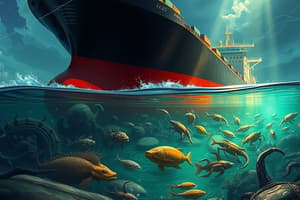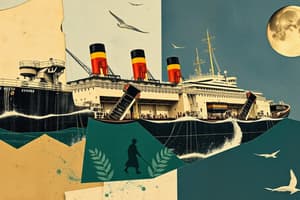Podcast
Questions and Answers
What is the primary requirement for new ships regarding ballast water treatment systems according to the convention?
What is the primary requirement for new ships regarding ballast water treatment systems according to the convention?
- Must have systems installed by September 2024
- Must have systems installed before first voyage
- Must have systems installed by September 2017 (correct)
- Must submit operational plans for approval
Which of the following methods is NOT identified for ballast water treatment?
Which of the following methods is NOT identified for ballast water treatment?
- Filtration and separation
- Ultraviolet radiation
- Biological enrichment method (correct)
- Chemical treatment using sodium hypochlorite
What is the minimum standard for ballast water treatment according to the D2 standard?
What is the minimum standard for ballast water treatment according to the D2 standard?
- 10 organisms per liter (correct)
- 100 organisms per cubic meter
- 10 organisms per cubic meter
- 1000 organisms per liter
Which treatment method involves reducing oxygen levels in ballast water?
Which treatment method involves reducing oxygen levels in ballast water?
What is the deadline for existing ships to install approved ballast water treatment systems?
What is the deadline for existing ships to install approved ballast water treatment systems?
Which of the following is not considered a physical treatment method for ballast water?
Which of the following is not considered a physical treatment method for ballast water?
Which factor is NOT involved in the sequential method of ballast water management?
Which factor is NOT involved in the sequential method of ballast water management?
Why is sodium hypochlorite used in ballast water treatment?
Why is sodium hypochlorite used in ballast water treatment?
What is a significant environmental impact of ballast water management regulations?
What is a significant environmental impact of ballast water management regulations?
Which of the following is a potential concern if a ship's ballast water treatment facility fails?
Which of the following is a potential concern if a ship's ballast water treatment facility fails?
Which of the following is a requirement for all ships over 400 GT regarding ballast water management?
Which of the following is a requirement for all ships over 400 GT regarding ballast water management?
What does a ship receive upon meeting the requirements of the Ballast Water Management Convention?
What does a ship receive upon meeting the requirements of the Ballast Water Management Convention?
Which of the following scenarios qualifies as an exemption from ballast water regulations?
Which of the following scenarios qualifies as an exemption from ballast water regulations?
What is the primary concern associated with deep water ballast water exchange according to the D1 standard?
What is the primary concern associated with deep water ballast water exchange according to the D1 standard?
In terms of environmental impacts, what should be avoided during ballast operations?
In terms of environmental impacts, what should be avoided during ballast operations?
Which of the following is NOT a suggested guideline for ballast water management?
Which of the following is NOT a suggested guideline for ballast water management?
What is the primary purpose of the Ballast Water Management Convention?
What is the primary purpose of the Ballast Water Management Convention?
What actions are suggested to be taken when the ship deviates from its planned route?
What actions are suggested to be taken when the ship deviates from its planned route?
What distance from land is defined for ballast water operations on open sea under exemption rules?
What distance from land is defined for ballast water operations on open sea under exemption rules?
Which of the following is NOT a requirement for ships under the Ballast Water Management Convention?
Which of the following is NOT a requirement for ships under the Ballast Water Management Convention?
Which treatment method is commonly used to manage ballast water before discharge?
Which treatment method is commonly used to manage ballast water before discharge?
Which of the following is a reason for port state control to inspect a ship’s ballast water logbook?
Which of the following is a reason for port state control to inspect a ship’s ballast water logbook?
Which entities are exempt from the regulations set forth in the Ballast Water Management Convention?
Which entities are exempt from the regulations set forth in the Ballast Water Management Convention?
Krigsskip are exempt from the Ballast Water Management Convention because they are primarily used for:
Krigsskip are exempt from the Ballast Water Management Convention because they are primarily used for:
What significant environmental impact is caused by the introduction of foreign organisms through ballast water?
What significant environmental impact is caused by the introduction of foreign organisms through ballast water?
In what year was the Ballast Water Management Convention ratified by Norway?
In what year was the Ballast Water Management Convention ratified by Norway?
What percentage of global trading tonnage was represented by the 52 states that ratified the convention by 2024?
What percentage of global trading tonnage was represented by the 52 states that ratified the convention by 2024?
Which department in Norway oversees the environmental aspects of the Ballast Water Management Convention?
Which department in Norway oversees the environmental aspects of the Ballast Water Management Convention?
What is a critical mechanical process involved in ballast water treatment?
What is a critical mechanical process involved in ballast water treatment?
What is the definition of ballast water as per the regulations?
What is the definition of ballast water as per the regulations?
What is one of the primary purposes of the Ballast Water Management Plan (BWMP)?
What is one of the primary purposes of the Ballast Water Management Plan (BWMP)?
Which type of ballast has become standard practice in modern ships due to its availability and cost-effectiveness?
Which type of ballast has become standard practice in modern ships due to its availability and cost-effectiveness?
What problem associated with ballast water was discovered after the implementation of segregated ballast systems?
What problem associated with ballast water was discovered after the implementation of segregated ballast systems?
Which of the following organisms is known to have caused significant ecological disruption when introduced via ballast water?
Which of the following organisms is known to have caused significant ecological disruption when introduced via ballast water?
What is a potential consequence of introducing Mikroalgen Chattonella verruculosa in new ecosystems?
What is a potential consequence of introducing Mikroalgen Chattonella verruculosa in new ecosystems?
What annual volume of ballast water is pumped in Norwegian ports?
What annual volume of ballast water is pumped in Norwegian ports?
Which of the following is NOT a type of ballast commonly used historically before the adoption of water ballast?
Which of the following is NOT a type of ballast commonly used historically before the adoption of water ballast?
What is one regulatory exemption that ships may qualify for regarding ballast water management?
What is one regulatory exemption that ships may qualify for regarding ballast water management?
What challenge does polluted ballast water pose to marine ecosystems?
What challenge does polluted ballast water pose to marine ecosystems?
Which of the following practices is encouraged for managing ballast water effectively?
Which of the following practices is encouraged for managing ballast water effectively?
What was a significant finding regarding the environmental impact of ballast water management in Norway?
What was a significant finding regarding the environmental impact of ballast water management in Norway?
Flashcards
Ballastvann
Ballastvann
Sjøvann som pumpes inn i skip for å opprettholde stabiliteten under losse- og lasteoperasjoner.
Kontaminert ballastvann
Kontaminert ballastvann
Ballastvann som inneholder skadelige organismer eller patogener.
Segregert ballastvann
Segregert ballastvann
Ballastvann som holdes i separate tanker fra skipets andre vannlagre.
Blindpassasjerer
Blindpassasjerer
Signup and view all the flashcards
Mikroalgen Chattonella verruculosa
Mikroalgen Chattonella verruculosa
Signup and view all the flashcards
Ballast Water Management Plan (BWMP)
Ballast Water Management Plan (BWMP)
Signup and view all the flashcards
Marine økosystem
Marine økosystem
Signup and view all the flashcards
Miljøødeleggelse
Miljøødeleggelse
Signup and view all the flashcards
Skipets stabilitet
Skipets stabilitet
Signup and view all the flashcards
Ballast Water Management Plan
Ballast Water Management Plan
Signup and view all the flashcards
Ballast Water Management Certificate
Ballast Water Management Certificate
Signup and view all the flashcards
Ballast Water Record Book
Ballast Water Record Book
Signup and view all the flashcards
Ballasting/De-ballasting
Ballasting/De-ballasting
Signup and view all the flashcards
Port State Control
Port State Control
Signup and view all the flashcards
Exceptions to Ballast Water Regulations
Exceptions to Ballast Water Regulations
Signup and view all the flashcards
Deep Water Ballasting
Deep Water Ballasting
Signup and view all the flashcards
Harmful Organisms
Harmful Organisms
Signup and view all the flashcards
Ship Stability
Ship Stability
Signup and view all the flashcards
Ballast tank cleaning
Ballast tank cleaning
Signup and view all the flashcards
Ballast Water Management
Ballast Water Management
Signup and view all the flashcards
Harmful Aquatic Organisms
Harmful Aquatic Organisms
Signup and view all the flashcards
Ballast Water
Ballast Water
Signup and view all the flashcards
IMO Convention
IMO Convention
Signup and view all the flashcards
Ratification
Ratification
Signup and view all the flashcards
Ecological Balance
Ecological Balance
Signup and view all the flashcards
Ship Stability
Ship Stability
Signup and view all the flashcards
Invasive Species
Invasive Species
Signup and view all the flashcards
BW Management Convention
BW Management Convention
Signup and view all the flashcards
Ballast Water Treatment
Ballast Water Treatment
Signup and view all the flashcards
Sequential Method
Sequential Method
Signup and view all the flashcards
Flow-through Method
Flow-through Method
Signup and view all the flashcards
Ballast Water Treatment System (BWTS) D2 Standard
Ballast Water Treatment System (BWTS) D2 Standard
Signup and view all the flashcards
Mechanical Treatment
Mechanical Treatment
Signup and view all the flashcards
Physical Treatment
Physical Treatment
Signup and view all the flashcards
Chemical Treatment
Chemical Treatment
Signup and view all the flashcards
Sodium Hypochlorite (NaOCl)
Sodium Hypochlorite (NaOCl)
Signup and view all the flashcards
IMO Ballast Water Convention
IMO Ballast Water Convention
Signup and view all the flashcards
Ship Ballast Water Costs
Ship Ballast Water Costs
Signup and view all the flashcards
BWTS Installation Timeline
BWTS Installation Timeline
Signup and view all the flashcards
Study Notes
Ballast Water Management
- Ballast water management is crucial for reducing the release of invasive species into the marine environment.
- The International Maritime Organization (IMO) ballast water convention was implemented to address this issue.
- The convention was adopted in 2004, and Norway ratified it in 2007. From September 08, 2017, the convention applies to all vessels engaged in international voyages.
- Currently, 52 countries have ratified the convention, encompassing 35.1441% of global shipping tonnage.
- The convention requires a minimum of 30 signatory states representing at least 35% of the total tonnage for the convention to apply.
- The goal is to reduce the risk of invasive species spreading via ballast water, safeguarding marine ecosystems.
Learning Outcomes
- Understanding the rationale behind the ballast water convention.
- Defining the purpose of the convention.
- Knowledge of IMO regulations and guidelines.
- Understanding methods to reduce invasive organism release.
- Importance of establishing safe ballast water exchange procedures.
- Ensuring clean ballast water discharge procedures.
Norwegian Contribution to the BW Convention
- Norway and the Norwegian Maritime Directorate played a key role in the convention's development.
- Norway was among the initiating nations in the convention's implementation.
- The Maritime Directorate was one of the first nations to ratify the convention.
- The Directorate collaborated with DNV-GL and other Norwegian partners to actively participate in convention implementation.
- The Ministry of Climate and Environment serves as the environmental focal point for the agency.
- The Shipowners' Association has worked extensively to encourage adoption of the convention.
Threats to the Marine Environment
- Invasive species spread through ballast water negatively impact marine environments.
- Invasive species often lack natural predators in a new environment, leading to rapid population growth.
- Rapid population growth disproportionately affects the local ecological balance.
- The convention aims to combat these dangers.
- Invasive species are transported in ballast water, altering the balance of the local marine ecosystems.
Significance of Ballast
- Ballast water is essential for maintaining ship stability.
- Ballast water ensures optimal ship design and load-carrying capacity.
- This stability is necessary to maintain the correct trim and draft for ship design requirements, particularly for ships with large cargo capacities.
Types of Ballast
- Ballast water historically comprises materials like stones, mud, and sand, which are more common in older vessels. However, modern ships primarily use water as ballast.
- This water is readily available; using water ballast is inexpensive, making it a popular choice.
- Water used as ballast can potentially contain diverse species.
- Ballast can be used, and reused, with minimal equipment requirements.
- In most modern ports, millions of tons of ballast water are exchanged yearly.
Bulk Carriers and Ballast
- Bulk carriers use ballast water exchange procedures during loading and unloading.
- The process involves pumping out old ballast water and introducing new water when the vessel is loaded or unloaded.
Invasive Species (Stowaways)
- Invasive species spread through ballast water pose a serious threat to marine ecosystems.
- Ballast water is taken on at the cargo's starting port and released at its destination port; this is often in various different geographical locations, further contributing to the spread of undesired organisms.
- These non-indigenous species may cause damage due to competition with local species or predation.
- Example: The comb jelly (Mnemiopsis leidyi) negatively affected fish populations in the Black and Caspian Seas.
Consequences of Introducing Invasive Species
- Rapid increase in population of introduced species, disrupting native food chains and impacting local fish stocks.
- Introduction of species that may cause substantial harm to existing marine ecosystems.
- Introduction of species that can out-compete native species for resources.
- Interference and harm to local indigenous populations. This impacts not just the existing marine life but also commercial fishing industries.
Algal Blooms and Ballast Water
- Chattonella verruculosa, an algae, is introduced into various oceans, potentially creating harmful algal blooms threatening marine life.
- Harmful algal blooms can cause significant economic harm. For example, the algae can be very poisonous, resulting in the death of numerous farmed fish in various ports around the globe.
Ballast Water Management Plan (BWMP)
- BWMP is necessary for effective management.
- A formal plan ensures safe and efficient processes.
- All vessels exceeding 400 GT must maintain a comprehensive ballast water exchange plan.
- Plans must detail the procedures to be used.
- A ballast water log is mandatory to record all exchange activities.
Exceptions and Exemptions
- Exceptions exist for vessels operating solely within a nation's territorial waters or exclusive economic zone. Military vessels may also be excluded.
- Ballast exchange regulations might vary in unnavigable waters or specific territorial areas.
- Exemptions might be granted for vessels facing excessive delays. Ballast water disposal may also be allowed to safeguard human lives.
IMO Guidelines for Ballast Water Management
- Guidelines aim to prevent invasive species from spreading through ballast water.
- Guidelines focus on minimising ballast water discharge.
- Procedures to reduce the chance of harming other species.
- Guidelines focus on controlling the spread of problematic species.
Ballast Water Treatment Systems (D1/D2 Standards)
- Vessels must meet the minimum standards (D1/D2).
- The IMO establishes requirements for ballast water treatment systems, specifying permitted levels of microbes and algae.
- Ships equipped with compliant systems can meet those standards.
- The implementation of these standards varies based on vessel class and size, taking into consideration the limitations for smaller ships compared to larger vessels.
Methods for Treating Ballast Water
- Mechanical Methods: Filtration, separation
- Physical Methods: Ultraviolet radiation, electric current, electrolysis and heat treatment
- Chemical Methods: Introduction of disinfectants, such as sodium hypochlorite
Ballast Water Change Methods
- Sequential Method: Empties one tank while filling another.
- Flow-Through Method: Overfills tanks with seawater then pumps out the water or a portion of it.
Cost Implications for the Norwegian Fleet
- The Norwegian fleet faces significant costs associated with ballast water management regulations.
- New treatment systems are essential for compliance and to address economic losses relating to environmental damage and fishing industry losses.
Further research/information
- There is a YouTube link to a video on ballast water management: https://www.youtube.com/watch?v=VhfKIOMSPdA
- There is a website for further information on ballast water management: http://www.imo.org
Studying That Suits You
Use AI to generate personalized quizzes and flashcards to suit your learning preferences.




